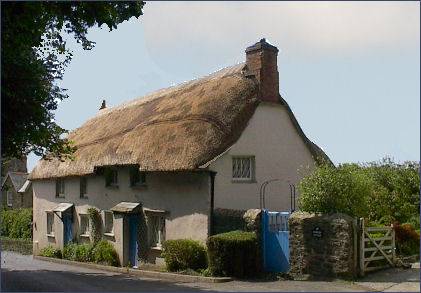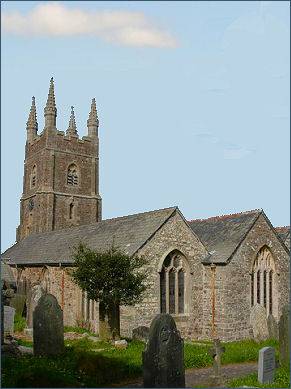Poughill
OS Grid ref:- SS 2207
 The attractive and historic hamlet of Poughill, pronounced "Pofil", is situated a mile to the north of the town of Bude in the far north of Cornwall. The hamlet is known in Cornish as Fentenvoekka.
The attractive and historic hamlet of Poughill, pronounced "Pofil", is situated a mile to the north of the town of Bude in the far north of Cornwall. The hamlet is known in Cornish as Fentenvoekka.
Poughill is an ancient settlement which is mentioned in the Domesday Book of 1086 where it is referred to as Pochelle. Burshill Manor, an open hall house of cob and stone rubble, dates to the late medieval era while Church House was built in 1525. The village pub, the Preston Gate Inn, serves home cooked food every day.
The village's water-mill is located on the footpath towards Bush. Lying at the foot of Trevalgus Hill in thick woodland, it is believed to have been a manorial mill for Trevalgus Manor. The mill was powered by the stream which runs south towards Stratton called the Stratt. Part of the mill building was constructed of timbers from ships wrecked along the coastline.
 During the latter part of his life, Sir Goldsworthy Gurney, the surgeon, gentleman scientist, inventor, and pioneer of applying steam power, lived in Reeds, a small house on the outskirts of Poughill, until his death in 1875.
During the latter part of his life, Sir Goldsworthy Gurney, the surgeon, gentleman scientist, inventor, and pioneer of applying steam power, lived in Reeds, a small house on the outskirts of Poughill, until his death in 1875.
The Battle of Stamford Hill was fought on the outskirts of Poughill during the Civil War on 16 May 1643.The Parliamentarian army were positioned around an Iron Age hill fort on the summit of Stamford Hill. The Royalist commander, Ralph Hopton, 1st Baron Hopton and Lord Mohun led the first column of the Royalist army from the south, Major-General Basset attacked from the north, Sir Bevil Grenville and Sir Nicholas Slanning led their columns from the west.
The Royalist infantry fought their way relentlessly up the steep slopes of the hill with neither side gaining, Major-General James Chudleigh led a the Parliamentarian pikemen in a downhill charge that penetrated deep into Sir Bevil Grenville's column. Grenville himself was knocked over, but Sir John Berkeley rallied the Royalists and made a desperate counter-charge that succeeded in turning the tide of the battle. Chudleigh was taken prisoner and finally the Parliamentarian line collapsed and they began to flee, leaving 300 dead and 1,700 prisoners. Hopton's victory temporarily secured Cornwall for King Charles I.
Each May, on the closest weekend to the anniversary, there is a two day re-enactment of the battle, fought over the Saturday and Sunday, together with a procession through the streets of neighbouring Stratton village.
The Poughill Revel and Cuckoo Fair takes place in the centre of the village. It is a traditional English village fete welcoming holiday makers and other visitors, with a mix of activities to try (archery, horse riding, treasure hunts, and other children's games) and plenty of homemade cakes and homegrown produce to sample.
St Olaf's Church
 St Olaf's Church, a Grade I listed building, is regarded as one of the treasure houses of Cornwall.
St Olaf's Church, a Grade I listed building, is regarded as one of the treasure houses of Cornwall.
The church is dedicated to St Olaf, King of Norway, who played a significant role in the Christianisation of that country and was killed in 1030 at the Battle of Stiklestad and became the patron saint of Norway.
The south aisle dates to the fourteenth and fifteenth centuries and he porch and west tower to the fifteenth century. During a restoration carried out in 1928 the foundations of the original Norman church were uncovered but nothing of this remains above ground.
The piscina and aumbry in the south chancel are thirteenth century as is the churches font. The 78 bench-ends tell the story of the Passion in remarkable detail. The old Iychgates are kept in the tower and the huge Royal Coat of Arms is dated 1655, a reminder that the Headquarters of Sir Bevil Grenville, during the Civil War, was at nearby Stowe Barton. n memory of Sir Goldsworthy Gurney, inventor of the 'Bude Light'
A wall of frescoes which date from about 1470 depict St Christopher (pictured left) : they were discovered in 1894 beneath layers of whitewash. Such paintings were once common in churches, the Poughill accounts record the washing-out of the figures in 1550 at the time of the Reformation. According to the legend, St Christopher was a heathen giant who, on turning Christian, was instructed by a holy hermit to carry travellers over a dangerous ford, and who, one stormy night carried the child Jesus on his shoulder.